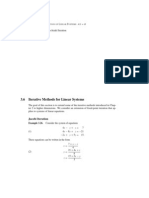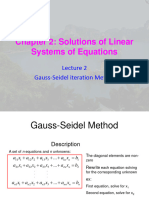Assignment 2
Uploaded by
Anu GauAssignment 2
Uploaded by
Anu GauAssignment 2: Numerical Solution of System of Linear Equations
1. Use (a) Jacobi method and (b) Gauss-Seidel iteration method to
approximate the solution of the following system of linear
equations. Continue the iterations until two successive
approximations are identical when rounded to three significant
digits.
x-x x -
-x x x
5 1 2 2 +3 3 = 1
x -x - x
3 1 +9 2 + 3 = 2
2 1 2 7 3 = 3.
2. Apply 5 iterations of (a) the Jacobi method and (b) the Gauss-Seidel
iteration method to approximate the solution of the following system
of linear equations using the initial approximation
x x x ) = (0, 0, 0).
x -x
( , ,1 2 3
x-x x -
2 1 2 = 0
-x x - x -
1 3 2 + 3 = 2
1 + 2 3 3 = 6.
-
- - x
1 4 1
3. Consider the system of linear equations = . Apply three
4 1 0
iterations of the Gauss-Siedel method to the system. Use the initial
estimate [0.25, 0.25] T .
4. Which of the following systems of linear equations has a strictly
diagonally dominant coefficient matrix?
x -x - x x -x -
x x -
4 1 +2 2 3 = 1
x x
3 = 4
a. b.
1 2
x-x x
1 +2 3 = 4
2 1 +5 2 = 2,
3 1
5 2
+ 3
= 3.
5. Computationally show that Gauss-Seidel method applied to the
following system of equations diverges
x-x x
- x x -x -
3 1 6 2 +2 3 = 23
x-x x
4 1 + 2 3 = 8
approximations as x =0.9, x - x
1 3 2 +7 3 = 17.
Take the initial = 3.1, = 0.9. 1 2 3
Interchange the first and second equations and solve the resulting
system by the Gauss-Seidel method. Again take the initial
approximations as =0.9, = 3.1, x x
= 0.9, and obtain the result - x
x
1 2 3
correct to two decimal places. The exact solution is =1.0,
x - x
1
= 2
3.0, = 1.0. 3
6. For the solution of the system of equations
x
- y
3 2 0 5
- z
2 3 1 4
0 1 2 1
setup the relaxation method. Perform three iterations of
(i) the SOR method with relaxation parameter 𝜔 = 1.25
(ii) the SUR method with relaxation parameter 𝜔 = 0.8
starting with (x,y,z)=(0,0,0).
You might also like
- WORKSHEET BCA5004 NUMERICAL METHOD unit 4No ratings yetWORKSHEET BCA5004 NUMERICAL METHOD unit 41 page
- ME 261 Numerical Analysis: System of Linear EquationsNo ratings yetME 261 Numerical Analysis: System of Linear Equations15 pages
- Gauss-Seidel Method 2. Jacobi Method: Iterative Methods For Linear System of EquationsNo ratings yetGauss-Seidel Method 2. Jacobi Method: Iterative Methods For Linear System of Equations37 pages
- COMSATS University, Islamabad: Islamabad Campus Department of Computer ScienceNo ratings yetCOMSATS University, Islamabad: Islamabad Campus Department of Computer Science5 pages
- Gauss Seidel Iteration Method, Convergence AnalysisNo ratings yetGauss Seidel Iteration Method, Convergence Analysis20 pages
- Lecture Note on Eie 419 (Numerical Methods Week 4No ratings yetLecture Note on Eie 419 (Numerical Methods Week 440 pages
- Chapter 3 The Iterative Solving Method For Linear System of EquationsNo ratings yetChapter 3 The Iterative Solving Method For Linear System of Equations27 pages
- Interactivos 100726191952 Phpapp01 - 2 PDFNo ratings yetInteractivos 100726191952 Phpapp01 - 2 PDF38 pages
- Multiple-Choice Test Gauss-Seidel Method of Solving Simultaneous Linear EquationsNo ratings yetMultiple-Choice Test Gauss-Seidel Method of Solving Simultaneous Linear Equations11 pages
- Jacobi and Gauss Seidal Iterative MethodNo ratings yetJacobi and Gauss Seidal Iterative Method8 pages
- SEAMBooks SPCE DCCN Gauss Seidel StudentsNo ratings yetSEAMBooks SPCE DCCN Gauss Seidel Students8 pages
- Birla Institute of Technology and Science, Pilani KK Birla Goa CampusNo ratings yetBirla Institute of Technology and Science, Pilani KK Birla Goa Campus2 pages
- MAFE208IU-L5 - Linear Systems of Equations - Part 2No ratings yetMAFE208IU-L5 - Linear Systems of Equations - Part 213 pages



































































